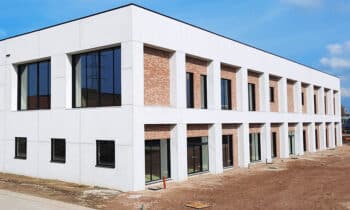
Meet The Next Gen building blocks
Circular, cement-free and CO2-negative!
Soundblox acoustic concrete blocks have been a trusted weapon in the fight against noise pollution for years. These acoustic concrete blocks are the ideal solution for acoustic climate control, where important aspects such as acoustics (both sound absorption and sound insulation) and fire resistance can be combined in one structural wall. From now on, Soundblox will not only be used for sound absorption, but also for CO2! No superfluous luxury when you consider that concrete is responsible for 10% of the total CO2 emissions worldwide! By deploying a new technology, Soundblox actively contributes to the climate transition, with 'cement-free' eventually becoming the norm. And that without making concessions to the aesthetic design of a space.

Robust acoustics
Soundblox acoustic concrete blocks, because of their robustness and ball resistance, have been used for years in rooms with high walls and ceilings such as sports and gymnasiums, but also, for example, in a reception hall, reception, school classroom, corridor and auditorium, house of worship, theater, library, factory, facade, office, conference room, hangar, etc. In addition, they are used in outdoor applications, along highways, stations and under overpasses and have been used more frequently in the past in nuclear power plants. In wet rooms, where not only room acoustics are an additional challenge but where, due to high humidity or other extreme conditions, special requirements are also placed on the materials, Soundblox can be the solution for acoustic climate control. For example, the room acoustics in swimming pool 'Jonfosse' in Liège (BE) were brought up to standard with Soundblox, with these acoustic building blocks providing a decorative addition to the interior. From now on, these acoustic concrete blocks are also available in a more durable variant. And the regular vision blocks, with which Soundblox can be combined in a wall, are also available in this new material.

Soundblox Carbstone: fully circular, cement-free and CO2-negative
So now Soundblox can also be produced in a new, carbonized variant, where they still have the advantages of concrete, but no longer the ecological disadvantages. Unlike traditional concrete blocks, these blocks are manufactured with CO2, which is specially extracted from the air and used in production. The new acoustic Carbstone is barely distinguishable from traditional concrete and has virtually the same properties. Like the well-known acoustic concrete blocks, the carbonized Soundblox are equipped with the characteristic and familiar Helmholtz resonators for the absorption of sound, which is absorbed through the openings of the blocks and into the sound chambers behind them.
Revolutionary technology
The advantage of this technology is that more CO2 is absorbed during production than emitted. Even after being incorporated into the wall, Soundblox continues to absorb CO2, further increasing its load-bearing capacity. In addition, this material is also fully recyclable. Although Soundblox are still available in concrete, Sound-less Acoustics wants to use this technology to actively contribute to the climate transition, in which cement-free production will eventually become the norm.




